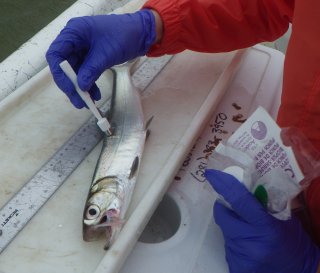National Coastal Condition Assessment 2015 Key Findings
National Coastal Condition Assessment: A Collaborative Survey of the Nation’s Estuarine and Nearshore Great Lakes Waters
Key Findings
The National Coastal Condition Assessment (NCCA)[1] reports on the health of estuarine and Great Lakes nearshore waters nationally as well as for four regional estuarine areas (the Northeast, Southeast, Gulf Coast, and the West Coast) and each of the Great Lakes separately. This summary includes four indicators for ecological health and three indicators related to recreational use of these essential resources.
Estuaries
Most estuarine waters are in good biological condition with low levels of contaminants in sediments.
- More than 75% of the estuarine area has good sediment quality based on measures of chemical contaminants found in sediments and laboratory tests of toxicity. Sediments serve as critical indicators of estuarine condition because they can accumulate contaminants that may enter the food web via bottom-dwelling organisms.
Most estuarine waters have low levels of bacteria and microcystin and are safe for recreation.
- For information on bacteria and algal toxins in specific water bodies, people should check with local or state health departments before swimming, boating, or fishing.
Nutrient pollution is widespread in the nation’s estuaries.
- Excess nutrients were found in 2/3 of the estuarine area. Eutrophication can contribute to harmful algal blooms, red tides, and fish kills.
High contaminant levels in Prey Fish in estuaries could pose a risk for the food-web.

- The levels of contaminants in prey fish in 75% of the estuarine area could lead to adverse effects, such as stunted growth or reduced reproduction, in fish and wildlife that eat them.
Mercury was detected in all estuarine fish fillet plug samples collected, but was above human health benchmarks in only 2% of the area.
- This indicator was not assessed in 43% of estuarine area, where fish appropriate for human consumption were not caught.
- A fish fillet “plug” is a small biopsy sample taken from a live fish. The fish is released after sampling.
- PCBs and PFOS in whole fish fillets were only assessed in Great Lakes nearshore waters.
- Recreational anglers should consult local fish consumption advisories before eating their catch.
Great Lakes
Most Great Lakes waters have low levels of contaminants in sediments.
-
However pockets of highly contaminated sediments are still found in some Great Lakes harbors and tributaries.
-
Sediments are critical indicators of estuarine condition because they can accumulate contaminants and may enter the food web via bottom-dwelling organisms.
Most Great Lakes waters have low levels of bacteria and microcystin and are safe for recreation.

- For information on bacteria and algal toxins in specific water bodies, people should check with local or state health departments before swimming, boating, or fishing.
Nutrient pollution is widespread in the Great Lakes.
- Eutrophication is a persistent problem in the Great Lakes with almost half of the nearshore area in fair or poor condition; Lake Erie experienced the most eutrophication, with 67% of the nearshore waters in fair or poor condition.
Great Lakes fish contain high levels of contaminants
- 100% of the assessed nearshore area contained fish with detectable levels of PFOS, mercury, and PCBs in their fillet tissue and exceedances of health-based benchmarks ranged from 5% to 79%.
- Recreational anglers should consult local fish consumption advisories before eating their catch.
High contaminant levels in Prey Fish in the Great Lakes could pose a risk for the food-web.
- The levels of contaminants in prey fish in 66% of the Great Lakes nearshore area could lead to adverse effects, such as stunted growth or reduced reproduction, in fish and wildlife that eat them.
[1] Results above are based on a statistically representative sampling of 1,060 sites: 699 in estuaries and 361 in the Great Lakes representing 27,479 square miles and 7,118 square miles, respectively.
